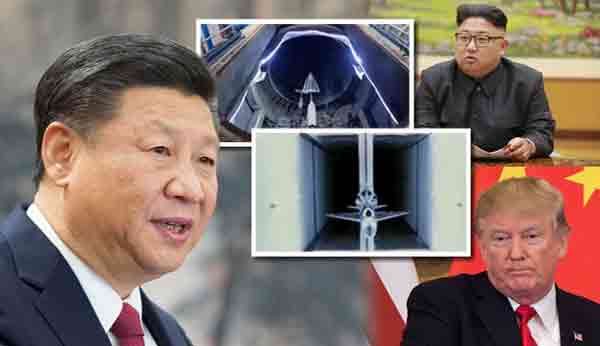

Rare photos reveal China’s hypersonic ‘dragon’ strike aircraft and tunnel. Photo: Gettty/CCTV
Beijing, China (BBN) - It comes as a US warship carried out threatening manoeuvres near the contested Chinese islands in the South China Sea last month.
China has previously described US military drills in the region as behaviour that “threatened the sovereignty of the South China Sea countries”, reports UK based newspaper The Express.
Now in a rare broadcast, Beijing has revealed what is believed to be four of its super speed strike aircraft, including the ‘hyper dragon’ and its new hypersonic tunnel.
The October 8 broadcast, which has newly emerged, shows the JF12 shock wave wind tunnel being used for testing.
A high-speed strike vehicle part can be seen hoisted by a crane into the tunnel which has been built in the nation’s capital Beijing.
The JF12 can reportedly produce speeds of up to Mach 9 – NASA’s hypersonic wind tunnel reaches to only Mach 7.
A technician from the Chinese Academy of Sciences, Jiang Zonglin, claimed its power was it was at least comparable to an unspecified "renowned" US wind tunnel.
According to Jiang, tests at the JF12 are conducted every two days and the facility will be operating at full capacity by the end of the year.
US intelligence agencies have also identified China’s hypersonic glider known as DF-ZF being tested in the footage.
DF-ZF glider, which can be launched atop a ballistic missile, is capable of manoeuvring at speeds of between Mach 5 and Mach 10—3 or 836 miles per hour and 7,672 miles per hour.
China's defence ministry has previously confirmed the first flight test of its DF-ZF but sought to play down the arms development.
The ministry said: ”Our planned scientific research tests conducted in our territory are normal.
"These tests are not targeted at any country and at any specific goals."
It comes as military experts fear Russia and China are developing a missile which will be 25 times faster than an aeroplane.
The new missiles will be highly manoeuvrable - unlike current rockets - and be able to fly at up to 25,000km per hour (15,534mph) and will also be able to get between altitudes ranging from a few tens of kilometres to 100km, which is much lower or higher than current surface-to-air missile systems.
The trio of characteristics means they will be highly unpredictable to their targets and will only be traceable six minutes before they hit, giving nations almost no time to react.
US Air Force general John Hyten, Commander of the Strategic Command, said he worried about the development of hypersonic missiles by China and Russia.
He said: ”Hypersonic technology is concerning to me, but it's really no more concerning to me than any cruise missile technology, any ballistic missile technology.
"We have to be prepared to defend ourselves against all those threats. And we have to have a deterrent that is ready to respond in case any of those break out."
His comments came as the US’ National Air and Space Intelligence Centre released a report which warned that hypersonic missile are a new threat.
The report said: "The combination of high speed, manoeuvrability, and relatively low altitude makes them challenging targets for missile defence systems.”
China has also been developing a new highway towards North Korea which experts believe could be part of a contingency plan to invade North Korea or amass their huge army on their shared border amid World War 3 fears.
The photos reveal the communist superpower is building a six-lane highway in its desolately populated north east on route to North Korea.
With most Chinese peasants not able to afford the luxury of a car the construction of the G1112 Ji'an–Shuangliao Expressway, has led experts to believe it will be used for quick deployment of tanks and troops to its North Korean border.
Scott Snyder, senior fellow for Korea studies and director of the program on US-Korea policy at the Council on Foreign Relations, told Daily Star Online: “China's Jilin province has even budgeted and paid for improvements in road infrastructure inside some parts of North Korea in recent years in order to improve logistical access to the Rason port inside North Korea.”
Dean Cheng, an Asia security expert at the Heritage Foundation think tank in Washington, said Beijing would have a ”vast array" of contingency plans involving military options to seize Kim Jong-un’s nuclear weapons.
BBN/MMI/ANS